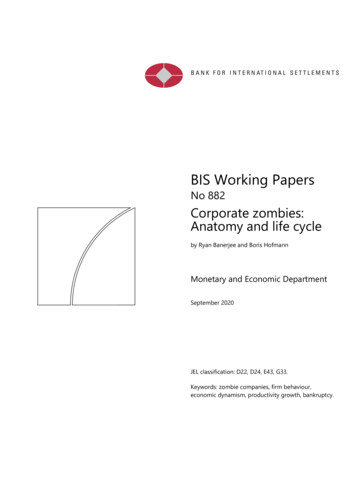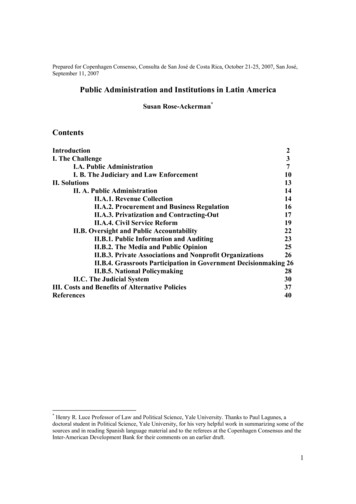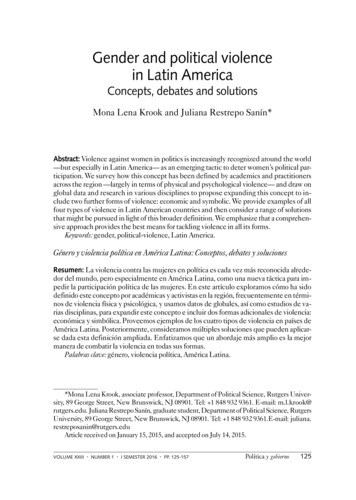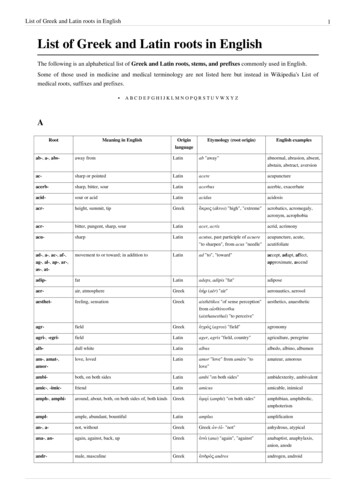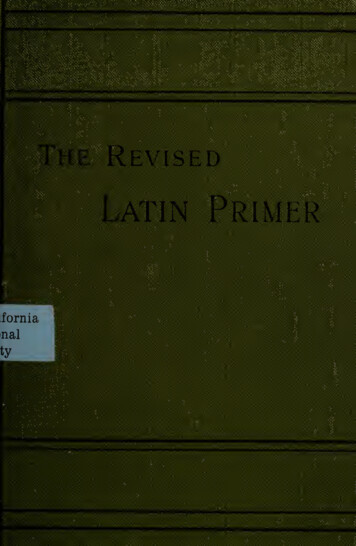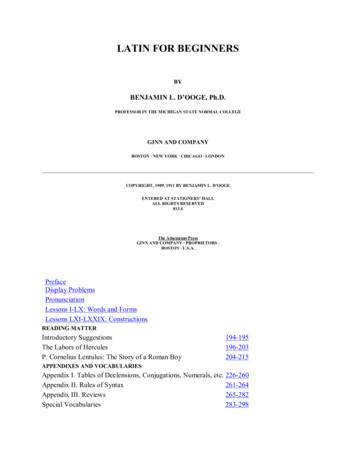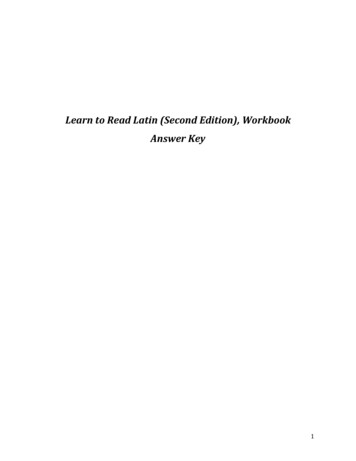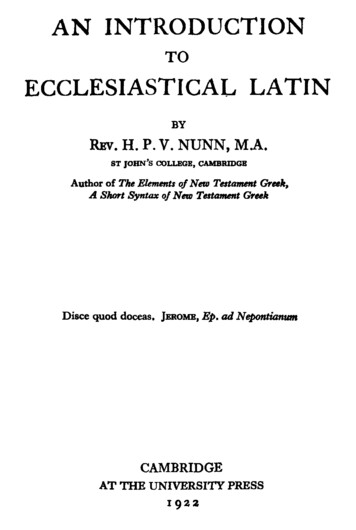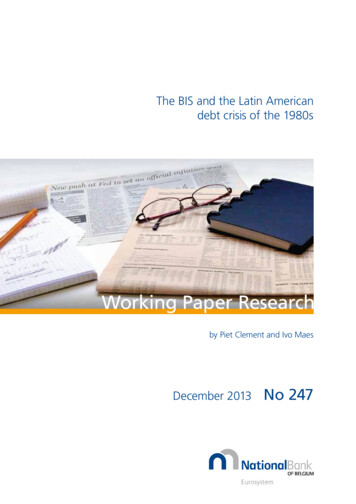
Transcription
National Bank of BelgiumLimited liability companyRLP Brussels – Company’s number : 0203.201.340www.nbb.beEditorJan SmetsMember of the Board of directors of the National Bank of Belgium Illustrations : National Bank of BelgiumLayout : Analysis and Research GroupCover : NBB AG – Prepress & ImagePublished in December 2013
AbstractThe Latin American debt crisis, which broke out in August 1982, was the first global financial crisisin the postwar period. While the crisis started in the "periphery", it constituted a threat to the "core"of the world economy, as the banking system was under severe pressure. Alongside the IMF, theBIS played an important role in coordinating the international response to the crisis. Moreover, a lotof work at the BIS in the second half of the 1970s had aimed at restraining the debt build-up.Discussions on the rising debt levels were highly influential in shaping the BIS view of financialstability, with the "macroprudential" concept at its core. However, in the analysis of the debt buildup, the role of financial innovations was not really captured. In this paper, we focus on the LatinAmerican debt crisis, discussing first the debt build-up, different initiatives to restrain lending andthe BIS role in the management of the crisis. We then turn to the ensuing efforts to strengthen thefinancial system and the emerging BIS approach to financial stability.Key words: Latin American debt crisis, BIS, macroprudential, financial fragility, LamfalussyJEL codes: A11, B22, B32, E3, F02, G10, N10Corresponding authors:Piet Clement, Bank for International Settlements, Basel - e-mail: piet.clement@bis.orgIvo Maes, NBB, Research Department, Robert Triffin Chair, Université catholique de Louvain andICHEC Brussels Management School - e-mail: ivo.maes@nbb.beThe authors would like to thank all those who contributed to this project, especially P. Butzen,Y. Cassis, H. Famerée, C. Schenk, J. Smets, C. Van Nieuwenhuyze and participants at theEuropean University Institute, WEHC (University of Stellenbosch), the Italian Society of Economists(Matera) and ESHET Argentina meetings.The views expressed are those of the authors and do not necessarily reflect those of the NationalBank of Belgium or of the BIS. The usual caveats apply.NBB WORKING PAPER No. 247 - DECEMBER 2013
TABLE OF CONTENTS1.Introduction . 12.The 1970s: The BIS in a changing international monetary and financial system . 13.The Latin-American debt build-up . 34.BIS efforts at restraining the debt build-up . 64.1A risk office . 64.2Burns' checklist . 74.3A joint meeting of the ECSC and the BCBS . 84.4Working parties on the Euro-currency markets . 95.The BIS role in the management of the debt crisis . 136.Strengthening the financial system and the BIS macro-prudential approach . 196.1Improved monitoring . 196.2Strengthening international banks . 206.3Towards a macro-prudential approach? . 227.Conclusion . 25References . 27National Bank of Belgium - Working papers series . 29NBB WORKING PAPER - No.247 - DECEMBER 2013
1INTRODUCTIONThe Latin American debt crisis, which broke out in August 1982, was the first globalfinancial crisis in the postwar period. While the crisis started in the "periphery", itthreatened the "core" of the world economy, as the banking system was under severepressure. The Bank for International Settlements (BIS) played an important role in themanagement of this crisis, especially in the provision of "bridging loans" (before IMFstabilisation loans could be accorded). Moreover, its statistics were invaluable for policymakers to quickly identify the banks involved in the debt crisis and their level of exposure.The Latin American debt build-up was also the first occasion on which the central bankingcommunity at the BIS reflected on a macroprudential approach to financial stability. Overtime, the BIS has developed a broad approach to financial stability, "marrying" the microand macroprudential dimensions (Crockett, 2000).This paper starts with a section on the Bank for International Settlements and its changingrole in the 1970s. We then go on to the Latin American debt build-up in the second half ofthe 1970s and the different initiatives discussed at the BIS aimed at restraininginternational lending. These discussions were influential in shaping the BIS view offinancial stability, especially the "macroprudential" dimension. However, they also showthat the role of financial innovations in the debt build-up was not really captured,illustrating the need to combine the micro- and macro approaches. Thereafter we go intothe BIS role in the management of the crisis, which was successful in preventing the crisisspreading from the periphery to the core and thus triggering a worldwide financialmeltdown. Finally, we discuss efforts at strengthening the financial system and thedevelopment of the macroprudential concept in the aftermath of the crisis. Thus, the LatinAmerican debt crisis is looked at in this study from the specific viewpoint of central banksand regulators and particularly the BIS1.2THE 1970S: THE BIS IN A CHANGING INTERNATIONAL MONETARY ANDFINANCIAL SYSTEMThe Bank for International Settlements was set up in 1930 to administer German warreparation payments and serve as a forum for central bank cooperation. The BIS providedcentral bankers with three main services: research on issues relevant to internationalpayments and prudential supervision, a venue for regular and discreet meetings, and afinancial arm (particularly important in the gold market). In the postwar period, Basel was1For a recent analysis of the 1980s Latin American debt crisis and a comparison with the euro area debtcrisis, see Eichengreen et al., 2013.1
one of the main centres of international monetary cooperation, contributing to thelongevity and success of the Bretton Woods system (Toniolo, 2005). It was during thisperiod that the Group of Ten (G10) of most industrialised countries established itself asone of the main organisational groupings for international financial cooperation, both atthe IMF and the BIS.2From the perspective of the central banks, one of the most significant financialdevelopments in the 1960s was the emergence of the so-called Euro-currency market, amarket for short-term deposits and credits denominated in a currency different from that ofthe country in which the deposit-taking or credit-giving bank was located (at that time,most commonly dollar-denominated deposits held in European banking centres: so-calledEuro-dollars). London established itself as the main centre of the euro-currency market,which between 1963 and 1973 expanded by up to 40% annually.3 This prompted the G10central banks into action. They asked the BIS to undertake a wide-ranging survey and tocompile regular statistics on Euro-currency operations. In April 1971, the governors went astep further by creating a dedicated Euro-currency Standing Committee (ECSC), with theobjective to monitor the rapid growth of international banking markets more closely.4However, in spite of concerns about the size and volatility of the Euro-currency market,the central banks did not intervene to try to regulate it or restrain its growth.5 The onlymeasure taken was a temporary agreement in 1971 to reduce the central banks’ ownholdings in the Euro-currency market.The collapse of the Bretton Woods system in the early 1970s, contributed significantly to ashift in the objectives of central bank cooperation. It went hand in hand with a moregeneral shift from a government-led to a market-led financial system (Maes, 2007). Withfloating exchange rates, increasing capital mobility and financial liberalisation (also insidecountries), the focus of cooperation shifted away from monetary stability towards financialstability (Clement, 2008, 6). The high-profile collapse of certain banks, like Herstatt andFranklin National, also contributed to this shift. In December 1974, the central bankGovernors of the G10 countries set up the Basel Committee on Banking Regulations and2345The G10 consisted of Belgium, Canada, France, (West) Germany, Italy, Japan, the Netherlands, Sweden,the United Kingdom and the United States. Switzerland soon joined as an associated member.For an analysis of the emergence and growth of the Euro-markets see: Schenk, 1998; and Battilossi andCassis, 2002.In 1999, the ECSC was renamed Committee on the Global Financial System (CGFS). It exists to this day.Its mandate is to identify and assess potential sources of stress in global financial markets, to further theunderstanding of the structural underpinnings of financial markets, and to promote improvements to thefunctioning and stability of these markets. (see: http://www.bis.org/cgfs/index.htm).This outcome reflected the substantial differences among the central banks in their approach towards theEuro-markets (Toniolo, 2005, 466). Most continental European central banks, especially the Bundesbank,distrusted the Euro-markets, blaming them for hot capital flows which hindered their monetary policyoperations and for complicating the supervision of their domestic banks. They argued for stringentregulations. Other central banks, especially the Bank of England, promoted the Euro-markets and rejectedcontrols.2
Supervisory Practices (BCBS).6 Like the ECSC, the BCBS was made up of high-rankingexperts from the G10 central banks, supported by a BIS-based secretariat. Bothcommittees reported directly to the G10 central bank Governors who met in Basel onalmost a monthly basis. The creation of the BCBS led to an agreement allocating crossborder supervisory responsibilities for internationally active banks among memberauthorities, the so-called "Concordat", in 1975. This was followed by the development ofgood practice guidelines and standards in all areas of banking regulation and supervision.3THE LATIN-AMERICAN DEBT BUILD-UPThe quadrupling of oil prices in November 1973 marked a turning point in the worldeconomy. It was an important factor behind the stagflation of the 1970s and contributed tonew balance of payments imbalances, with significant surpluses in the oil producingcountries and a sharp deterioration for the oil importing countries (both developed andless developed countries). The oil price shock had also major consequences forinternational banking. The Euro-currency markets, earlier distrusted for their allegeddestabilising effects, now were a useful vehicle for recycling the petrodollar surpluses ofthe OPEC countries to countries with balance of payments deficits. With the recycling, thefocus of attention at the ECSC shifted to lending to developing countries, which wasgrowing at a tremendous pace (see chart 1). At first, this recycling was largely beneficialto the world economy. However, it also implied that the international banking system wasfaced with an increase in country risk. At the ECSC meeting in December 1975, KitMcMahon from the Bank of England observed that concern was growing "about theindebtedness . of a large number of non-industrial countries, about the role that the Eurocurrency market had played since the emergence of the oil surplus and about the possibleconsequences of these factors in the coming year".767The name was later changed to Basel Committee on Banking Supervision, BCBS.Note on a meeting of the ECSC held on 8 December 1975, BISA 7.15(1), G10 D22.3
Chart 1Non-oil Developing Countries' External Debt, 1973-1982Source: IMF.The BIS was sufficiently concerned to discuss publicly the increasing indebtedness ofcertain countries, as well as its increasingly short-term character. In a speech in 1976,Alexandre Lamfalussy, then Economic Advisor at the BIS, drew attention to the threat of acrisis: "[looking at]. the continuous growth of credits, the spread of risks to a largenumber of countries, and the change in the nature of credits – I draw the conclusion thatthe problem of risks has become a very urgent one.” (Lamfalussy, 1976, 5).However, in 1976 and 1977, the current account deficits of several developing countries,particularly in Latin America, improved, mainly because of adjustment policies and therecovery in the world economy. But, in 1978, riding the wave of a worldwide borrowers'market, adjustment policies were abandoned and the deficits increased again significantly.For Lamfalussy (1978), important causes of this borrowers' market were loose monetary4
policies and the US current account deficit, which was "pumping liquidity into theinternational financial system".The crucial role of the banking sector also implied that the IMF, with its conditionalfinancing, only played a minor part in the financing of current account deficits during thisperiod of debt build-up. Lamfalussy (1978) warned against relying uniquely on thefinancial markets and for a sudden stop of lending. "There are not many examples ofsuccessful conditional lending by the private banking system; and in the absence of a prenegotiated gradual adjustment program, the only way private banks can set into motiondomestic adjustment policies is when they stop lending. This has happened in somecases; and when it happened, it did so fairly abruptly. Gradual adjustment, under thewisely-dosed pressure of conditional lending by the IMF would clearly be preferable to thisdrastic medicine".The debt build-up was also stimulated by financial innovations, in particular thegeneralised use of floating interest rates in medium-term bank loans. During thepetrodollar recycling, this allowed banks to protect themselves against the erosion of theirintermediation margins. However, it also had the effect of passing on short-term marketinterest rate movements to borrowers (see chart 2). Negative real interest rates in the1970s boosted demand for credit, leading to a period of over-expansion. The increase inreal interest rates from 1979 onwards, mainly due to the tightening of US monetary policyunder Fed Chairman Paul Volcker (leading to a decline in the dollar prices of LatinAmerican exports as well), placed a crippling burden on many debtors. The ensuing debtcrisis threatened the entire world financial system.5
Chart 2Average real percentage interest rate on developing country floating-rate debtSource: Maddison, 1985, 47.4BIS EFFORTS AT RESTRAINING THE DEBT BUILD-UPIn this section, we focus on behind-the-scenes efforts undertaken from the mid-1970s tomoderate international bank lending. We discuss four major initiatives: a proposal tocreate a risk office at the BIS, the so-called Burns' checklist initiative, a joint meeting of theEuro-currency Standing Committee and the Basel Committee of Bank Supervisors, andworking parties on the Euro-currency markets.4.1A risk officeIn 1976, Alexandre Lamfalussy (re-)launched the idea of setting up a central risk office8.His idea was that the 40 or 50 major internationally active commercial banks wouldsubmit, directly to the BIS, information on their claims on individual countries. Theinformation would also comprise a breakdown into the major categories of borrowers(banks, non-banks, governments, multinationals, etc.), and a broad maturity structure.9 Heargued that this would provide a much better picture of the debt situation than theavailable data. This initiative also showed a key element of the BIS's "macroprudential"approach: a focus on key players of systemic importance, while also getting a better89An earlier suggestion of setting up an international risk office was rejected in 1965 (Toniolo, 2005, 469).Note by Lamfalussy, “Some remarks on the Memorandum on the Euro-currency market and regulations ofinternational financial flows”, 9 July 1976, BISA 7.18(15), LAM 27/F72.6
understanding of the broader macro situation. However, the idea of a risk office was nottaken up.4.2Burns' checklistIn 1977, Arthur Burns, then Chairman of the Fed, suggested drawing up a "checklist ofquestions" for banks which were lending to sovereign borrowers.10 The idea was to incitethe banks to have a look at the relevant economic indicators before taking their lendingdecisions (see Maes, 2011). This initiative followed after a first financial crisis in Mexico in1976. At the Federal Open Markets Committee meeting of 16 November 1976, Burns hadcriticised the Federal Reserve staff for being too lax regarding the Mexican financialsituation (Meltzer, 2009, 960).The "Burns' checklist" comprised two pages, with questions for information on "Countries'long-term external indebtedness" and "Short-term external liabilities and assets".11 TheBIS Monetary and Economic Department, especially Alexandre Lamfalussy and MichaelDealtry, was largely responsible for drafting the questionnaire. Together with therespective central banks, they contacted 57 international banks to sound out theirwillingness to take part in this arrangement.During the preparations for the "checklist", several central bankers were critical of theidea. For instance, Pierre Languetin (of the Swiss National Bank) observed that he "wasnot sure what the aim of the proposed questionnaire was. Was it to teach banking tobankers?" 12As observed in the concluding report to the Governors, the commercial banks werereluctant to take on Burns' questionnaire. The main reason was that they feared losinglucrative business to unfair competitors: "By far the biggest difficulty is seen as lying in thedegree of competition for foreign business that exists between banks. There was virtuallyno bank visited that did not take this point of view".13In their concluding report, Lamfalussy and Dealtry noted further that the idea of improvingthe information on debt was met positively by the banks and that several banks welcomedthe recent improvements in the data. However, they also noted that not all the banks knewabout the BIS statistics, a crucial tool for understanding their credit risks.10 US banks were particularly exposed to Latin American debt.11 "Suggested list of information to be requested by lending banks from, or with respect to, the externalfinancial situation of the country of residence of foreign borrowers", BISA, 7.18(12) DEA2.12 Dealtry, "Note on the meeting about information to be requested by banks from prospective borrowers inthe international credit markets, 18 June 1977, BISA, 7.18(12), DEA2.13 Report to the Governors on the reactions of commercial banks in Group of Ten countries and Switzerlandto Chairman Burns' proposed checklist, 26 October 1977, BISA 7.18(12) DEA2.7
Among the central banks, there was a discussion whether the checklist should bemandatory. Federal Reserve Board of Governors member Henry Wallich argued stronglyagainst this, "Stressin
floating exchange rates, increasing capital mobility and financial liberalisation (also inside countries), the focus of cooperation shifted away from monetary stability towards financial stability (Clement, 2008, 6). The high-profile collapse of certain banks, like Hersta
